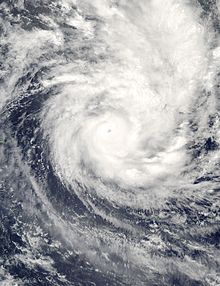 Cyclone Percy prior to peak intensity on March 1 | |
| Meteorological history | |
|---|---|
| Formed | February 24, 2005 |
| Dissipated | March 5, 2005 |
| Category 5 severe tropical cyclone | |
| 10-minute sustained (FMS) | |
| Highest winds | 230 km/h (145 mph) |
| Lowest pressure | 900 hPa (mbar); 26.58 inHg |
| Category 5-equivalent tropical cyclone | |
| 1-minute sustained (SSHWS/JTWC) | |
| Highest winds | 260 km/h (160 mph) |
| Lowest pressure | 898 hPa (mbar); 26.52 inHg |
| Overall effects | |
| Areas affected | American Samoa, Tokelau, Cook Islands |
| IBTrACS | |
Part of the 2004–05 South Pacific cyclone season | |
Severe Tropical Cyclone Percy was an extremely powerful tropical cyclone, which was the third and last Category 5 cyclone to form in the 2004–05 South Pacific cyclone season. The seventh named storm and the fourth and final severe tropical cyclone to form during the 2004–05 South Pacific cyclone season. Percy originated as a tropical disturbance on February 23. Over next few days, the system organized while moving east southeastward, before intensifying into a Category 1 tropical cyclone on the Australian region scale on February 26. The system quickly intensified, reaching Category 4 status later that day. On the next day, Percy was steered southward by a blocking ridge of high pressure, while stretched out the structure of the storm into an elliptical shape, weakening it back to Category 3 status. Afterward, the storm rapidly reintensified, reaching its peak intensity as a Category 5 tropical cyclone on March 2. Afterward, Percy encountered increasing wind shear and weakened once again, turning southeastward on the next day. On March 5, Percy transitioned into an extratropical storm, before dissipating soon afterward.
Percy was also the most damaging of the South Pacific February cyclones that year, as it battered the Cook Islands, which were still recovering from the impacts of Cyclones Meena, Nancy and Olaf. Percy then devastated the island of Tokelau, leaving many homeless and millions in dollars in property damages (although exact damage figures are unavailable). Because of warnings in anticipation of the storm, there were no deaths and there were only a few injuries.